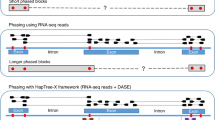Abstract
Rapid advances in high-throughput DNA sequencing technologies have enabled variant discovery from whole-genome sequencing (WGS) datasets; however linking variants on a chromosome together into haplotypes, also known as haplotype phasing, remains difficult. Human genomes are diploid and haplotype phasing is crucial for the complete interpretation and analysis of genetic variation.
Hapcut2 (https://github.com/vibansal/HapCUT2) is an open-source software for phasing diploid genomes using sequence data generated using different sequencing technologies and experimental methods. In this article, we give an overview of the algorithm used by Hapcut2 and describe how to use Hapcut2 for haplotype phasing of individual genomes using different types of sequence data.
Access this chapter
Tax calculation will be finalised at checkout
Purchases are for personal use only
Similar content being viewed by others
References
Bansal V, Halpern AL, Axelrod N, Bafna V (2008) An MCMC algorithm for haplotype assembly from whole-genome sequence data. Genome Res 18(8):1336–1346
Kitzman JO, Mackenzie AP, Adey A et al (2011) Haplotype-resolved genome sequencing of a Gujarati Indian individual. Nat Biotechnol 29(1):59–63. https://doi.org/10.1038/nbt.1740
Peters BA, Kermani BG, Sparks AB et al (2012) Accurate whole-genome sequencing and haplotyping from 10 to 20 human cells. Nature 487(7406):190–195. https://doi.org/10.1038/nature11236
Snyder MW, Adey A, Kitzman JO et al (2015) Haplotype-resolved genome sequencing: experimental methods and applications. Nat Rev Genet 16(6):344–358. https://doi.org/10.1038/nrg3903
Zheng GX, Lau BT, Schnall-Levin M et al (2016) Haplotyping germline and cancer genomes with high-throughput linked-read sequencing. Nat Biotechnol 34(3):303–311. https://doi.org/10.1038/nbt.3432
Chen Z, Pham L, Wu TC et al (2020) Ultralow-input single-tube linked-read library method enables short-read second-generation sequencing systems to routinely generate highly accurate and economical long-range sequencing information. Genome Res 30(6):898–909. https://doi.org/10.1101/gr.260380.119
Selvaraj SR, Dixon J, Bansal V et al (2013) Whole-genome haplotype reconstruction using proximity-ligation and shotgun sequencing. Nat Biotechnol 31(12):1111–1118. https://doi.org/10.1038/nbt.2728
Edge P, Bafna V, Bansal V (2017) HapCUT2: robust and accurate haplotype assembly for diverse sequencing technologies. Genome Res 27(5):801–812. 05
Bansal V, Bafna V (2008) HapCUT: an efficient and accurate algorithm for the haplotype assembly problem. Bioinformatics 24(16):i153–i159
Kuleshov V (2014) Probabilistic single-individual haplotyping. Bioinformatics 30(17):i379–i385
Patterson M, Marschall T, Pisanti N et al (2015) WhatsHap: weighted haplotype assembly for future-generation sequencing reads. J Comput Biol 22(6):498–509. https://doi.org/10.1089/cmb.2014.0157
Levy S, Sutton G, Ng PC et al (2007) The diploid genome sequence of an individual human. PLoS Biol 5(10):e254. https://doi.org/10.1371/journal.pbio.0050254
Author information
Authors and Affiliations
Corresponding author
Editor information
Editors and Affiliations
Rights and permissions
Copyright information
© 2023 The Author(s), under exclusive license to Springer Science+Business Media, LLC, part of Springer Nature
About this protocol
Cite this protocol
Bansal, V. (2023). HapCUT2: A Method for Phasing Genomes Using Experimental Sequence Data. In: Peters, B.A., Drmanac, R. (eds) Haplotyping. Methods in Molecular Biology, vol 2590. Humana, New York, NY. https://doi.org/10.1007/978-1-0716-2819-5_9
Download citation
DOI: https://doi.org/10.1007/978-1-0716-2819-5_9
Published:
Publisher Name: Humana, New York, NY
Print ISBN: 978-1-0716-2818-8
Online ISBN: 978-1-0716-2819-5
eBook Packages: Springer Protocols




